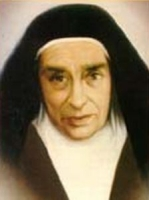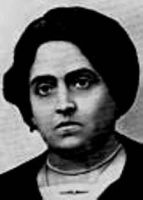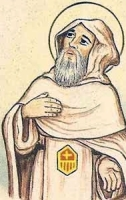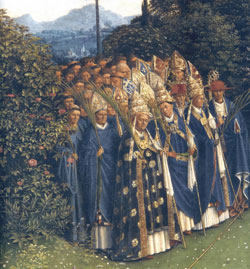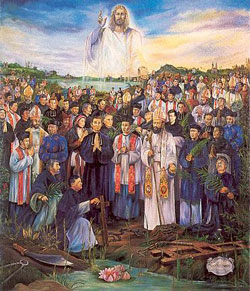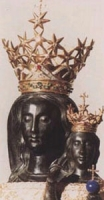Bl. Thomas Holland
Feastday: December 12
Death: 1642
English martyr. Also known as Thomas Sanderson and Thomas Hammond, he was born at Sutton, near Prescot, Lancashire, England, in 1600. Thomas left England to study at St. Omer, France, and Valladolid, in Spain, and entered the Jesuits after ordination in 1624. Going home, circa 1635, he worked to aid the Church in the isles for seven years until his arrest in London. Thomas was hanged, drawn, and quartered at Tyburn.
Thomas Holland (1600 at Sutton, Lancashire – executed 12 December 1642 at Tyburn) was an English Jesuit priest. He is a Catholic martyr, beatified in 1929.
Life
Holland was born in Lancashire, possibly son of Richard Holland, gentleman. He attended the English College at St. Omer's and subsequently in August, 1621, went to the English College, Valladolid.[1] When the abortive negotiations for the "Spanish Match" were taking place in 1623, Holland was sent to Madrid to assure Prince Charles of the loyalty of the seminarists of Valladolid, which he did in a Latin oration. [2]
In 1624 he entered the novitiate of the Society of Jesus at Watten in the Southern Netherlands, and not long after was ordained to priesthood at Liège.[3] He took the missionary oath 29 December 1633 and served as minister at Ghent and prefect at St. Omer's, where he acquired the nickname, bibliotheca pietatis ("Library of Piety") because of his vast knowledge of the ascetical life.[3]
He made his solemn religious profession as spiritual coadjutor at Ghent (28 May 1634) and was sent on the English mission the following year, in hopes that the change might improve his health.[1]
Holland worked in London, sometimes assuming the aliases of Saunderson and Hammond. He was an adept in disguising himself, and could speak perfect French, Spanish, and Flemish. He had to stay indoors during the day and only travel at night because of the priest-hunters. His health did not improve.[4]
He was eventually arrested on suspicion in a London street returning from a sick call, 4 October 1642, and committed to the New Prison. He was afterwards transferred to Newgate, and arraigned at the Old Bailey, 7 December, for being a priest. There was no conclusive evidence as to this; but as he refused to swear he was not, the jury found him guilty,[1] to the indignation of the Lord Mayor, Isaac Penington, and another member of the bench named Garroway. On Saturday, 10 December, Sergeant Peter Phesant, presumably acting for the recorder, passed sentence on him. On his return to prison Holland heard many confessions.
Some Capuchin friends smuggled in supplies so he could celebrate Mass one last time. Soon after his last Mass he was taken off to execution. There he was allowed to make a speech and to say many prayers, and when the cart was turned away, he was left to hang till he was dead.[4]
Our Lady of Guadalupe
குவாதலூப் அன்னை
இடம்:
தேபியாக் குன்று, மெக்சிகோ நகரம்
(Tepeyac Hill, Mexico City)
தேதி: டிசம்பர் 12, 1531
சாட்சிகள்:
புனிதர் ஜூவான் டியெகோ
(Saint Juan Diego)
வகை: மரியாளின் தரிசனம் (Marian Apparition)
கத்தோலிக்க புனித ஒப்புதல்: அக்டோபர் 12, 1895
குவாதலூப் அன்னைக்கு திருத்தந்தை பதின்மூன்றாம் லியோவால் புனித முடிசூட்டும் விழாவின்போது
(During the Canonical Coronation granted by Pope Leo XIII)
முக்கிய திருத்தலம்:
குவாதலூப் அன்னை பேராலயம், தேபியாக் குன்று, மெக்சிகோ நகரம், மெக்ஸிகோ
(Basilica of Our Lady of Guadalupe, Tepeyac Hill, Mexico City, Mexico)
திருவிழா நாள்: டிசம்பர் 12
பாதுகாவல்: மெக்ஸிகோ, அமெரிக்க நாடுகள், ஃபிலிப்பைன்ஸ், செபு
"குவாதலூப் அன்னை" என்பது இயேசுவின் அன்னையாம் தூய கன்னி மரியாளுக்கு கத்தோலிக்க திருச்சபையில் வழங்கப்படும் பெயர்களுள் ஒன்றாகும். குறிப்பாக இது, புனிதர் ஜூவான் டியெகோவின் மேற்போர்வையில் பதிந்துள்ள மரியாளின் திருவோவியத்திற்கு அளிக்கப்படும் பெயராகும். இத்திருஓவியம், தற்போது மெக்சிகோ நாட்டின் தலைநகரான மெக்சிகோ நகரிலுள்ள (Basilica of Our Lady of Guadalupe) குவாதலூப் அன்னை பேராலயத்தில் பாதுகாக்கப்படுகின்றது.
இப்பேராலயமானது, மெக்சிக்கோவின் மிகவும் புகழ்பெற்ற சமய மற்றும் கலாச்சார சின்னமாகக் கருதப்படுவது மட்டுமல்லாது, உலகின் அதிக திருயாத்திரீகர்கள் தரிசித்த கத்தோலிக்க திருத்தலமுமாகும். இவ்வோவியத்தில் இருக்கும் அன்னை மரியாளுக்கு மெக்சிக்கோவின் அரசி, என்னும் பெயரும் உண்டு. குவாதலூப் அன்னை என்னும் பட்டத்தின் கீழ் ஒருகாலத்தில் ஃபிலிப்பைன்சின் பாதுகாவலியாகவும் அன்னை மரியாள் அறியப்பட்டார். (ஆயினும் இது 1935ம் ஆண்டு, திருத்தந்தை பதினொன்றாம் பயஸால் நீக்கப்பட்டது). 1999ல் திருத்தந்தை இரண்டாம் அருள் சின்னப்பர் குவாதலூப் அன்னை என்னும் பட்டத்தின் கீழ் தூய கன்னி மரியாளை அமெரிக்காக்களின் பாதுகாவலி, இலத்தீன் அமெரிக்காவின் அரசி, மற்றும் கருவிலிருக்கும் குழந்தைகளின் பாதுகாவலி என அழைத்துள்ளார்.
திருவோவியத்தின் வரலாறு:
புதிய உலகின் பூர்வீக இனமான அஸ்டெகிலிருந்து மனமாறி கிறிஸ்தவ மறையினைத் தழுவியவரும், ஏழை விவசாயியுமானவர் ஜூவான் டியெகோ (Juan Diego). அக்காலத்தில் ஸ்பேனிஷ் பேரரசில் மரியாளின் அமல உற்பவம் விழா டிசம்பர் 9ம் தேதியன்று சிறப்பிக்கப்படும் வழக்கம் இருந்தது. இவ்விழா நாளான டிசம்பர் 9ம் தேதி 1531ம் ஆண்டு, ஜூவான் டியெகோ அதிகாலையில் தனது கிராமத்தில் ஆலயம் ஏதும் இல்லாததால், மெக்சிகோ நகரிலுள்ள ஆலயம் ஒன்றில் திருப்பலியில் பங்கு கொள்வதற்காக தேபியாக் குன்று வழியாக நடந்து சென்று கொண்டிருந்தார். அப்போது, அக்குன்றின் உச்சியில், சூரியனைப் போன்ற பிரகாசமான ஒளியைக் கண்டதாகவும். அதிலிருந்து இனிமையான இசையைக் கேட்டதாகவும் நம்பப்படுகின்றது. பின்னர் அங்கிருந்து ஒரு பெண்ணின் குரல், டியெகோவை அக்குன்றில் ஏறி வருமாறு அழைத்தது எனவும் டியெகோ அங்கு ஏறிச் சென்றபோது, விண்ணக மகிமையில், பிரகாசமான ஒளிக்கு மத்தியில் தூய கன்னி மரியாள் நிற்பதைக் கண்டார் என்கின்றனர். கன்னி மரியாள் டியெகோவின் தாய்மொழியான “நஹுவாட்ல்” மொழியில் (Nahuatl language) பேசி, தனக்காக ஒரு சிற்றாலயம் கட்ட வேண்டும் என மெக்சிகோ நகர ஆயரிடம் சொல்லும்படி டியெகோவை அனுப்பினார் என நம்பப்படுகின்றது.
டியெகோவும் மெக்சிகோ பேராயரான “ஜுவான் டி ஸுமர்ரகா” (Juan de Zumárraga) என்பவரிடம் சென்று அதனைத் தெரிவித்தபோது, ஆயர் டியெகோவை நம்பவில்லை. அடுத்த நாளும் ஆயரிடம் சென்று தனது ஆவலைத் தெரிவிக்குமாறு பணித்தார் அன்னை மரியாள். அதேபோல் டியெகோ ஆயரிடம் சென்று சொன்னதும், அக்காட்சிக்கு ஓர் அடையாளம் தருமாறு அப்பெண்ணிடம் கேட்குமாறு ஆயர் டியெகோவிடம் கேட்டுக்கொண்டார். அன்று மாலையே டியெகோ அன்னை மரியாளிடம் நடந்தததைச் சொன்னார். அன்னை மரியாளும் அடுத்த நாள் காலையில் அவரின் வேண்டுகோளை நிறைவேற்றுவதாக உறுதி கூறினார். ஆனால் டியெகோவின் மாமா “ஜூவான் பெர்னார்டினோ” (Juan Bernardino), திடீரென கடும் நோயால் தாக்கப்பட்டதால் அடுத்த நாள் அங்குச் செல்ல முடியவில்லை.
இறந்து கொண்டிருந்த தனது மாமாவுக்கு இறுதி திருவருட்சாதனம் கொடுப்பதற்காக, டிசம்பர் 12ம் தேதி, ஒரு குருவை அழைக்கச் சென்றார் டியெகோ. அப்போது அன்னை மரியாள், டியெகோவைச் சந்திப்பதற்காக தேபியாக் குன்றின் அடியில் இருந்த சாலையில் டியெகோவுக்கு காட்சியளித்து அவரின் மாமா நலமைடைவார், இறக்கமாட்டார் எனவும், உடனே தான் முன்னர் மூன்று முறை காட்சியளித்த தேபியாக் குன்றின் உச்சிக்குச் சென்று அங்கு பூத்துக்குலுங்கி இருக்கும் மலர்களை பறித்துக்கொண்டு தன்னிடம் வருமாறு கூறினார். இந்தப் பாறைக் குன்றின் உச்சியில் எந்தப் பூக்களும் பூக்க வாய்ப்பில்லை என்பது டியெகோவுக்குத் தெரிந்திருந்தும் அவர் அங்கு சென்றார். அங்கு அழகிய பூந்தோட்டம் இருப்பதைக் கண்டார். அவைகளைப் பறித்து தனது மேற்போர்வையில் பொதிந்து வந்து அன்னை மரியாளிடம் கொடுத்தார். அந்தப் பூக்களை அவரது மேற்போர்வையில் அழகுபடுத்திக் கொடுத்து அதை ஆயரிடம் கொண்டு போகச் சொன்னார் அன்னை மரியாள். ஆயரை நம்ப வைக்க, தான் தரும் அடையாளம் இதுவே என்று சொல்லி அனுப்பினார்.
டியெகோ, மெக்சிகோ பேராயரான “ஜுவான் டி ஸுமர்ரகா” (Juan de Zumárraga) என்பவரின் முன்னால் போய் நின்று, தனது மேற்போர்வையைத் திறந்து காண்பித்தார். அதிலிருந்து மலர்கள் கொட்டின. ஆனால் ஆயர் மற்றும் டியெகோவின் கண்களையே நம்ப முடியாத வகையில் டியெகோவின் மேற்போர்வையில் அழகிய அன்னை மரியாளின் திருஉருவம் பதிந்திருந்தது. டியெகோ எப்படி வர்ணித்திருந்தாரோ, அதேமாதிரியான உருவம் அதில் இருந்தது. அதே நாளில் அன்னை மரியாள், டியெகோவின் மாமா “ஜூவான் பெர்னார்டினோ” (Juan Bernardino) முன்பும் தோன்றி நலம் அளித்தார். பெர்னார்டினோ, தனக்கு நடந்த புதுமையையும் ஆயரிடம் கூறுமாறு அன்னை மரியாள் சொல்லியிருந்ததை டியெகோவிடம் சொன்னார். அத்துடன் தனது இந்த உருவத்தை “குவாதலூப் அன்னை” என்ற பெயரில் அழைத்து தனக்கு வணக்கம் செலுத்துமாறும் பெர்னார்தினோவிடம் அன்னை மரியாள் சொல்லியிருந்தார். இன்றளவும் ஏறக்குறைய 500 ஆண்டுகளாக அன்னை மரியாள், இப்பெயரிலேயே இங்கு அழைக்கப்பட்டு வருகிறார்.
Also known as
• Holy Mary of Guadalupe
• Virgin of Guadalupe
• Maria de Guadalupe
Profile
Guadalupe is, strictly speaking, the name of a picture, but the name was extended to the church containing the picture and to the town that grew up around the church. It makes the shrine, it occasions the devotion, it illustrates Our Lady. It is taken as representing the Immaculate Conception, being the lone figure of a woman with the sun, moon, and star accompaniments of the great apocalyptic sign with a supporting angel under the crescent. The word is Spanish Arabic, but in Mexico it may represent certain Aztec sounds.
Its tradition is long-standing and constant, and in sources both oral and written, Indian and Spanish, the account is unwavering. The Blessed Virgin appeared on Saturday 9 December 1531 to a 55 year old neophyte named Juan Diego, who was hurrying down Tepeyac hill to hear Mass in Mexico City. She sent him to Bishop Zumárraga to have a temple built where she stood. She was at the same place that evening and Sunday evening to get the bishop's answer. The bishop did not immediately believed the messenger, had him cross-examined and watched, and he finally told him to ask the lady who said she was the mother of the true God for a sign. The neophyte agreed readily to ask for sign desired, and the bishop released him.
Juan was occupied all Monday with Bernardino, an uncle, who was dying of fever. Indian medicine had failed, and Bernardino seemed at death's door. At daybreak on Tuesday 12 December 1531, Juan ran to nearby the Saint James convent for a priest. To avoid the apparition and the untimely message to the bishop, he slipped round where the well chapel now stands. But the Blessed Virgin crossed down to meet him and said, "What road is this thou takest son?" A tender dialogue ensued. She reassured Juan about his uncle, to whom she also briefly appeared and instantly cured. Calling herself Holy Mary of Guadalupe she told Juan to return to the bishop. He asked Mary for the sign he required. She told him to go to the rocks and gather roses. Juan knew it was neither the time nor the place for roses, but he went and found them. Gathering many into the lap of his tilma, a long cloak or wrapper used by Mexican Indians, he came back. The Holy Mother rearranged the roses, and told him to keep them untouched and unseen until he reached the bishop. When he met with Zumárraga, Juan offered the sign to the bishop. As he unfolded his cloak the roses, fresh and wet with dew, fell out. Juan was startled to see the bishop and his attendants kneeling before him. The life size figure of the Virgin Mother, just as Juan had described her, was glowing on the tilma. The picture was venerated, guarded in the bishop's chapel, and soon after carried in procession to the preliminary shrine.
The coarsely woven material of the tilme which bears the picture is as thin and open as poor sacking. It is made of vegetable fibre, probably maguey. It consists of two strips, about seventy inches long by eighteen wide, held together by weak stitching. The seam is visible up the middle of the figure, turning aside from the face. Painters have not understood the laying on of the colours. They have deposed that the "canvas" was not only unfit but unprepared, and they have marvelled at apparent oil, water, tempera, etc. colouring in the same figure. They are left in equal admiration by the flower-like tints and the abundant gold. They and other artists find the proportions perfect for a maiden of fifteen. The figure and the attitude are of one advancing. There is flight and rest in the eager supporting angel. The chief colours are deep gold in the rays and stars, blue-green in the mantle, and rose in the flowered tunic.
Sworn evidence was given at various commissions of inquiry corroborating the traditional account of the miraculous origin and influence of the picture. Some wills connected with Juan Diego and his contemporaries were accepted as documentary evidence. Vouchers were given for the existence of Bishop Zumárraga's letter to his Franciscan brothers in Spain concerning the apparitions. His successor, Montufar, instituted a canonical inquiry, in 1556, on a sermon in which the pastors and people were abused for crowding to the new shrine. In 1568 the renowned historian Bernal Díaz, a companion of Cortez, refers incidentally to Guadalupe and its daily miracles. The lay viceroy, Enríquez, while not opposing the devotion, wrote in 1575 to Philip II asking him to prevent the third archbishop from erecting a parish or monastery at the shrine. Inaugural pilgrimages were usually made to it by viceroys and other chief magistrates. Processes, national and ecclesiastical, were laboriously formulated and attested for presentation at Rome, Italy in 1663, 1666, 1723, and 1750.
The clergy, secular and regular, has been remarkably faithful to the devotion towards Our Lady of Guadalupe, the bishops especially fostering it, even to the extent of making a protestation of faith in the miracle a matter of occasional obligation. Pope Benedict XIV decreed that Our Lady of Guadalupe should be the national patron of Mexico, and made 12 December a holiday of obligation with an octave, and ordered a special Mass and Office. Pope Leo XIII approved a complete historical second Nocturne, ordered the picture to be crowned in his name, and composed a poetical inscription for it. Pope Pius X permitted Mexican priests to say the Mass of Holy Mary of Guadalupe on the twelfth day of every month, and granted indulgences which may be gained in any part of the world for prayer before a copy of the picture.
The place, called Guadalupe Hidalgo since 1822, is three miles northeast of Mexico City. Pilgrimages have been made to this shrine almost without interruption since 1531-1532. A shrine at the foot of Tepeyac Hill served for ninety years, and still forms part of the parochial sacristy. In 1622 a rich shrine was erected, and in 1709 a newer, even richer one. There are also a parish church, a convent and church for Capuchin nuns, a well chapel, and a hill chapel all constructed in the 18th century. About 1750 the shrine got the title of collegiate, a canonry and choir service being established. It was aggregated to Saint John Lateran in 1754. In 1904 it was created a basilica, with the presiding ecclesiastic being called abbot. The shrine has been renovated in Byzantine style which presents an illustration of Guadalupan history.
Patronage
• Americas; New World
• Central America
• Mexico
• New Mexico
• Pojoaque Indian Pueblo
• 12 dioceses
• 3 cities
Saint Spyridon of Cyprus
Also known as
• Spyridon of Corfu
• Spyridon of Korfu
• Spyridon of Kerkyra
• Spyridon of Tremithus
• Spyridon of Trimithon
• Spyridon the Wonder Worker
• Spyridon Thaumaturgos
• Spiridion...
Additional Memorial
11 August (Corfu)
Profile
Known as a pious youth as he grew up on Cyprus. Shepherd. Married, and father one of daughter. Both his wife and daughter became nuns, and he became a monk at Mount Carmel.
Bishop of Tremithus, Cyprus. Spiritual teacher of Saint Tryphillius of Leucosia. Fought Arianism. During the persecution of Galerus, his right eye was torn out, his left calf cut off, and he was sent to forced labor in the Spanish mines. The Edict of Milan eventually freed him, and allowed him to return to his see, and attended the Council of Nicaea and Council of Sardica.
Legend says that he once ordered a gold ingot to resume its true form; it immediately turned into a serpent.
Another time, while listening to a deacon read Scripture, he saw that the lector was using his speaking ability to draw attention to himself, not the word of God. He silenced the deacon who immediately developed a stammer, understood his error, and lost all desire for people to notice his diction.
Converted a prominent philosopher by using a chunk of pottery to explain the Christian concept of the trinity (Father, Son and Holy Spirit, unified but distinct). He explained that pottery is made of the three elements of earth, fire, and water, and yet is unified into a single object. During this mini-lesson, water flowed from the bottom of the shard as fire miraculously billowed from the top - hence his patronage of potters.
Born
270 on Cyprus
Died
• c.348 of natural causes
• incorrupt corpse
Patronage
• against flood
• potters
• sailors
• 3 cities in Greece
Representation
• wearing a pointed cap
• shepherd standing in a sarcophogus
• shepherd's cloak
• holding a barb or awl or something similarly pointed referring to the gouging out of his eye
Saint Finnian of Clonard
Also known as
• Finian of Clonard
• Finden of Clonard
• Teacher of the Irish Saints
Profile
A pious youth, he founded three churches in Ireland while still a layman. Studied in Wales under Saint Cadoc of Llancarvan and Saint Gildas the Wise. Monk. Great admirer of Saint Patrick. Considered one of the great founders of Irish monasticism. Founded the monastery at Clonard, Meath, Ireland c.520 which lasted a thousand years, and was a training center for great Irish saints. Spiritual teacher of Saint Columba of Iona, Saint Columba of Terryglass, Saint Ciaran of Clommacnois, Saint Brendan the Voyager, Saint Nathy, Saint Nennius, Saint Ruadhan of Lorrha, Saint Daig MacCairaill, and others. Maintained close relations with the British Church. Often referred to as a bishop, there is no evidence he was ever so consecrated.
Legend attributes many miracles to him. Birds would gather around him because of his gentle holiness. Reported to have cleared parasitic insects, worms and vermin from the island of Flathlom and the regions of Nantcarfan. One story says that he fended off a party of Saxon raiders by causing an earthquake to swallow their camp.
Born
c.470 at Myshall, County Carlow, Ireland
Died
• c.549 to 552 at Clonard, Meath, Ireland of plague
• relics originally enshrined in Clonard, but were destroyed in the 9th century
Patronage
• Alexandria-Cornwall, Ontario, Canada, diocese of
• Meath, Ireland, diocese of
Blessed Ludwik Bartosik
Also known as
• Father Pio
• Father Pius
• prisoner 12832
Additional Memorial
12 June as one of the 108 Martyrs of World War II
Profile
Eldest son of Wojciech, a poor shoemaker, and Wiktoria Tomczyk. With the help of his parish priest, Ludwik obtained a good education. Joined the Franciscan Conventual Friars in 1926, taking the name Pius. Studied in Franciscan seminaries in Sanok, then Lviv and finally Krakow, Poland. Ordained on 23 June 1935. Noted confessor at the Franciscan convent in Krosno, Poland. At the request of Saint Maximilian Kolbe, Father Pius was transferred to the convent at Niepokalanów, Poland in August 1936 where he worked in a number of positions, including editor of the magazines Knight of the Immaculate, Little Knight of the Immaculate and Miles Immaculatae, all the while continuing to serve as confessor to his brother friars. Wrote a number of works including a noted book of Mariology. Imprisoned by invading German troops on 19 September 1939 and transferred to several prisons, finally ending at the Auschwitz forced labour concentration camp. He continued his vocation as confessor to other prisoners. Martyred in the Nazi persecutions of World War II.
Born
21 August 1909 in Kokanin, Wielkopolskie, Poland
Died
tortured to death during the night of 12 to 13 December 1941 in Oswiecim (a.k.a. Auschwitz), Malopolskie, Nazi-occupied Poland
Beatified
26 March 1999 by Pope John Paul II
Saint Vicelin of Oldenburg
புனிதர் விசெலினஸ்
"ஹோல்ஸ்டீன்" அப்போஸ்தலர்/ "ஓல்டேன்பர்க்" ஆயர்:
(Apostle of Holstein and Bishop of Oldenburg)
பிறப்பு: கி.பி. 1086
ஹமெலின், லோவர் ஸக்சொனி, ஜெர்மனி
(Hamelin, Lower Saxony, Germany)
இறப்பு: டிசம்பர் 12, 1154
நியூமுன்ஸ்ட்டர், செல்ச்விக்-ஹோல்ஸ்டீன், ஜெர்மனி
(Neumünster, Schleswig-Holstein, Germany)
ஏற்கும் சமயம்:
ரோமன் கத்தோலிக்க திருச்சபை
(Roman Catholic Church)
நினைவுத் திருநாள்: டிசம்பர் 12
புனிதர் விசெலினஸ், ஜெர்மனியின் "ஹோல்ஸ்டீன்" (Holstein) என்னும் இடத்திலுள்ள "ஓல்டேன்பர்க்" (Oldenburg) மறைமாவட்ட ஆயர் ஆவார். இவரே "ஹோல்ஸ்டீன்" அப்போஸ்தலராகவும் மதிக்கப்படுகிறார்.
கி.பி. 1086ம் ஆண்டு, ஹமெலின் (Hamelin) என்னும் இடத்தில் பிறந்த இவர், சிறுவயதிலேயே அநாதையாகிப் போனார். அருகாமையில் இருந்த ஒரு கிராமத்தில் மத குருவாக பணியாற்றிய தமது மாமன் "லுடோல்ஃப்" (Ludolf) என்பவரின் பராமரிப்பில் வளர்ந்தார். விரைவிலேயே “படேர்போர்ன்” (Paderborn) என்ற நகருக்கு ரகசியமாகச் சென்ற இவர், அங்கேயே வாழத் தொடங்கினார். நண்பர்களையும் இருப்பிடங்களையும் உருவாக்கிக் கொண்ட இவர், அங்குள்ள பேராலய பள்ளியின் நிர்வாகத்தில் உதவி புரியத் தொடங்கினார்.
விரைவில் "ஹம்பர்க்-ப்ரேமென்" (Hamburg-Bremen) என்ற உயர்மறை மாவட்டத்தின் பேராயர் “ஃபிரெடெரிக்” (Archbishop Frederick) அழைப்பின் பேரில் அங்கே சென்ற அவர், அங்குள்ள பள்ளியின் ஆசிரியர் மற்றும் பள்ளி முதல்வர் பணிகள் செய்யப் பணிக்கப்பட்டார்.
கி.பி. 1122ம் ஆண்டு, “லாவோன்” (Laon) நகரில் தமது கல்வியை நிறைவு செய்தார். கி.பி. 1126ல் “மட்கேபர்க்” (Madgeburg) நகருக்கு பயணம் செய்ய தீர்மானித்த விசெலினஸ், அங்கு பேராயராக இருந்த “புனிதர் நார்பர்ட்” (St. Norbert) அவர்களைச் சந்தித்தார். பேராயர் தமக்கு குருத்துவ அருட்பொழிவு செய்வார் எனவும் அதனால் தாம் அங்கே அடிமைகளாக இருந்த மக்களிடம் மறைபோதனை செய்யவும் விரும்பினார். ஆனால், ஒருசில காரணங்களுக்காக அது நடக்காமல் போனது. ஆகவே, அவர் “ப்ரேமன்” (Bremen) நகருக்கு திரும்பினார். அங்கே, ஆயர் “அல்பேரோ” (Bishop Albero) அவருக்கு குருத்துவ அருட்பொழிவு வழங்கினார்.
"ஹம்பர்க்-ப்ரேமென்" (Hamburg-Bremen) உயர்மறை மாவட்டத்தின் பேராயர் “அடால்பெரோ” (Hamburg-Bremen's Archbishop Adalbero) "போலாபியன்" அடிமைகளிடையே (Polabian Slavs) மறைபோதனை செய்ய அவரை அனுப்பினார்.
கி.பி. 1127ம் ஆண்டு, “ப்ரேமன்” (Bremen) திரும்பிய விசெலினஸ் சிறப்பான முறையில் மறை போதனை செய்தார். அவரது பிரசங்கங்கள் மக்களை ஈர்த்தன. சக மத குருக்களும் அவருக்கு புதிதாக ஒரு துறவிமடம் உருவாக்க உதவினர்.
கி.பி. 1149ம் ஆண்டு, பேராயர் “முதலாம் ஹார்ட்விக்” (Archbishop Hartwig I) விசெலினசை ஆயராக நியமனம் செய்தார்.
கி.பி. 1152ம் ஆண்டு, பக்கவாத நோயினால் கடுமையாக பாதிக்கப்பட்ட விசெலினஸ், தமது மரணத்துக்கு முன்னர் சுமார் இரண்டு வருடங்கள் வலி வேதனைகளால் அவஸ்தைப்பட்டார். நோயில் துன்புற்ற விசெலினஸ் கி.பி. 1154ம் ஆண்டு மரித்தார்.
Also known as
• Apostle of Holstein
• Apostle of Obodriten
• Vicelinus, Vincelin, Vizelin, Wissel, Witzel, Wizelin
Profile
Born to the nobility and orphaned young. Studied at Hameln, Germany and in the cathedral school of Paderborn, Germany. Canon at Bremen, Germany. Teacher and principal of the school at Bremen. Spiritual student of Saint Norbert of Magdeburg who ordained him. Missionary to the Wagrian Wends in northeastern Germany in autumn 1126, and to Slavs in surrounding areas. Founded monasteries at Neumunster, Holstein, Segeberg, and Hogersdorf. In 1147 most of what he had built and done was wiped out in a series of raids by pirates; he and several of his priests fled back to the Empire. Bishop of Oldenburg, Germany in 1149; known for the spirituality of his flock, and for his good works for the poor. His last two years he suffered a painful paralysis of the right side of his body resulting from an apparent heart attack and stroke.
Born
c.1088 in the castle at Hemeln on the Weser, Lower Saxony, Germany
Died
• 12 December 1154 at Neumunster, Lorraine, France of natural causes
• re-interred in front of the altar in Bordesholm in 1332
Representation
bishop with a church sitting on his left arm
Saint Edburga of Thanet
Also known as
• Edburga of Minster-on-Thanet
• Bugga, Eadburga, Edburgh, Heaburg
Profile
Only daughter of King Centwine and Queen Engyth of Wessex, the 8th century royal family of Kent, England. Benedictine nun. Friend and spiritual student of Saint Mildred of Thanet. Abbess of Minster-on-Thanet Abbey in 716. She secured several royal charters for the abbey, and built a new church there. Skilled scribe and calligrapher. Pilgrim to Rome, Italy where she met Saint Boniface with whom she established a lengthy correspondence; her letters have not survived. She supported Saint Boniface in his missionary work, and copied manuscripts for his use.
Born
English
Died
• 751 at Minster-on-Thanet abbey of natural causes
• buried in the abbey church beside Saint Mildred
• relics translated to Saint Gregory's Hospital, Canterbury, England
Pope Saint Callistus II
Also known as
• Calixtus II
• Guido of Burgundy
Profile
Born to the nobility. Uncle of the Queen of France, cousin of the King of England, related to the German Emperor. Benedictine monk. Archbishop of Vienne, France for over 30 years. Created cardinal by Pope Paschal II. Chosen 162nd Pope in 1119. Ended the investiture conflict. Presided over the First Lateran Council. Fought simony and concubinage of the clergy. Funded construction and beautification projects in Rome.
Born
c.1065 Quingey, France
Papal Ascension
1 February 1119
Died
13 December 1124 in Rome, Italy of natural causes
Saint Columba of Terryglass
Also known as
• Colum mac Crimthainn
• Colum moccu Loigse
• Columba of Tirdaglas
• Columba of Tyrdaglas
Profile
Son of Crinthainn. Disciple of Saint Finnian of Clonard; administered Last Rites to Saint Finnian on his death-bed. Spiritual director of Saint Caemban, Saint Fintan, and Saint Mocumin. Founded the monastery of Tirdaglas (Terryglass) in 548, and served as its abbot. Visited Tours, France, and brought back relics of Saint Martin of Tours. One of the Twelve Apostles of Ireland.
Born
at Leinster, Ireland
Died
• 13 December 552 of plague
• buried in Terryglass monastery
Blessed James of Viterbo
Also known as
• James Capocci
• James of Naples
• Doctor Speculativus
• Giacomo, Jacobus
Profile
Augustinian hermit at Viterbo, Italy . Received his doctorate from the University of Paris. Well-known theology teacher in Paris, France and Naples, Italy. Bishop of Benevento, Italy in 1302. Archbishop of Naples, Italy in 1303.
Born
c.1255 in Viterbo, Italy as James Capocci
Died
1308 of natural causes
Beatified
14 June 1911 by Pope Pius X (cultus confirmed)
Blessed Ida of Nivelles
Profile
Joined the Benedictine Cistercians at Kerkheim, Leuven, Belgium at age 16; the house, and Ida, were later moved to Rameige, Belgium, where she spent the rest of her life. Sister Ida was a mystic, a visionary and a miracle worker with a ministry of praying for suffering souls in Purgatory.
Born
c.1190 in Nivelles, Belgium
Died
12 December 1231 in Rameige, Belgium of natural causes
Patronage
• against toothache
• souls in Purgatory
Representation
• woman in a hospital bed holding the baby Jesus
• woman in a hosptial bed being given the baby Jesus by Mary
Saint Corentius of Quimper
Also known as
Corentin, Corentinus, Cury
Profile
Son of a British chieftain. Hermit at Plomodiern in Brittany. First bishop of Cornouaille, (modern Quimper), France, consecrated by Saint Martin. Signed the decrees of the Council of Angers in 453.
Legend says that when a hermit, he fed on a fish that would regenerate after Corentius had taken a piece of its flesh.
Died
c.490 of natural causes
Representation
hermit with a fish
Saint Conrad of Offida
ஒஃபிடா குரு கோன்ராட் Konrad von Offida
பிறப்பு
1237,
ஒஃபிடா, இத்தாலி
இறப்பு
12 டிசம்பர் 1306,
அசிசி, இத்தாலி
இவர் தன் 14 ஆம் வயதில் புனித பிரான்சிஸ் அசிசியின் சபையை அஸ்கோலி பிசேனோ (Ascoli Piceno) என்ற இடத்தில் நிறுவினார். இவர் மிக எளிமையான, ஏழ்மையான வாழ்வை வாழ்ந்தார். குடும்ப வாழ்வில் தான் வாழ்ந்த எளிமையை விடாமல் தொடர்ந்து வாழ்ந்தார். இவர் ஊரெங்கும் சென்று வீட்டு வேலை செய்து தன் துறவற சபையை காத்து வந்தார். இவர் பிறந்த ஊரில் 2 ஆம் பிரான்சிஸ் என்றழைக்கப்பட்டார். இவர் சிறப்பாக மறையுரை ஆற்றும் திறமையை பெற்றிருந்தார். வீதியெங்கும் சென்று மறையுரை ஆற்றினார். அனைத்து மக்களாலும், "சகோதரர்" என்றே அழைக்கப்பட்டார்.
இவர் 1265 ஆம் ஆண்டு அசிசி நகர் சென்றார். அங்கு போர்சிங்குலா லியோ (Portiancula Leo) வாழ்ந்த ஒரு சிறிய அறையை பார்வையிட்டார். பின்னர் அங்கிருந்து 14 செப்டம்பர் 1224 ஆம் ஆண்டு, புனித பிரான்சிஸ் அசிசி ஐந்து காய வரம் பெற்ற இடத்திற்கு சென்றார். அங்கிருந்த துறவற இல்லத்தில் 15 ஆண்டுகள் வாழ்ந்தார். இவர் இளைஞராக இருந்த போதிலிருந்தே கிறிஸ்துவின் மீது அளவில்லா ஆர்வம் கொண்டு, அவர் பணியை ஆர்வமுடன் ஆற்றி இடைவிடாமல் இறைவேண்டல் செய்து இறைவனடி சேர்ந்தார்.
Profile
Joined the Franciscans at age 14. Noted scholar who gave up his studies to be a cook in a convent. However, his superiors knew of his speaking skills and had him leave the kitchen for the pulpit, leading to a very successful career of preaching. Died while preaching.
Born
c.1241 in Offida, diocese of Ascoli Piceno, Italy
Died
12 December 1306 at Bastia, Umbria, Italy of natural causes
Saint Simon Phan Ðac Hòa
Profile
Married, father, family man, physician and mayor who worked with local charities and the missionaries working in the apostolic vicariate of Cochinchina (modern Vietnam). Imprisoned, flogged and executed for his faith in the persecutions of Minh Mang.
Born
c.1787 in Mai Vinh, Thua Thiên, Vietnam
Died
beheaded on 12 December 1840 in An Hòa, Quang Nam, Vietnam
Canonized
19 June 1988 by Pope John Paul II
Blessed Bartholomew Buonpedoni
Profile
Lay servant to the Benedictines in Pisa, Italy. Franciscan tertiary. Ordained at age 30. Village priest at Peccioli, Italy. When he contracted leprosy he gave up parish work to spend his remaining twenty years ministering to the lepers of his region, assisted by his long-time friend Blessed Vivaldus.
Born
San Geminiano, Italy
Died
1300 of natural causes
Saint Gregory of Terracina
Profile
Brother of Saint Speciosus. Spiritual student of Saint Benedict of Nursia. Benedictine monk at Terracina, Italy. Pope Saint Gregory the Great wrote of him in his Dialogues.
Died
c.570 of natural causes
Saint Agatha of Wimborne
Profile
Benedictine nun at Wimborne, England. Spiritual student of Saint Lioba of Bischofsheim with whom she travelled to Germany to help in the missionary work of Saint Boniface.
Died
790 of natural causes
Saint Colman of Clonard
Also known as
• Colman moccu Thelduib
• Colmanus
Profile
Related to Saint Finnian of Clonard. Monk. Abbot of Clonard Abbey.
Died
8 February 654 of natural causes
Blessed Martino Sanz
Profile
Friar and then Commander of the Mercedarian convent of Santa Maria della Mercede Arguines in Spain.
Saint Donatus the Martyr
Profile
Martyred with 23 companions.
Died
forced into a swamp to die of cold and exhaustion, date unknown
Saint Abra
Also known as
Abre
Profile
Daughter of Saint Hilary of Poitiers. Nun. Helped spread the faith around Poitiers, France.
Born
342
Died
360 of natural causes
Saint Cury
Also known as
Corentin
Profile
Fourth-century missionary from Brittany to the Cornwall area of England.
Born
Brittany, France
Died
401 of natural causes
Saint Synesius
Profile
Lector. Martyred in the persecutions of Aurelian.
Died
stabbed with a sword in 275 in Rome, Italy
Saint Colman of Glendalough
Profile
Abbot of Glendalough, Ireland.
Died
659
Saint Hermogenes
Profile
Martyred with 23 companions.
Died
forced into a swamp to die of cold and exhaustion
Saint Cormac
Profile
Sixth century abbot in Ireland. Friend of Saint Columba of Iona.
Martyrs of Alexandria
Profile
A group of six Christians martyred for their faith during the persecutions of Decius. We know little more than five of their names - Alexander, Ammonaria, Dionysia, Epimachus and Mercuria.
Died
burned to death c.250 in Alexandria, Egypt
Martyrs of Trier
Profile
A group of Christians murdered together for their faith in the persecutions of Decius - Constantius, Crescentius, Justin and Maxentius.
Died
c.287 at Trier (in modern Germany)
Also celebrated but no entry yet
• Arnoldo Martin
• Bertrando de Mas
• Giovanni de Josa
• Israele di Dorat
• Pribyslava
• Therapon of Monzja
• Valerico













